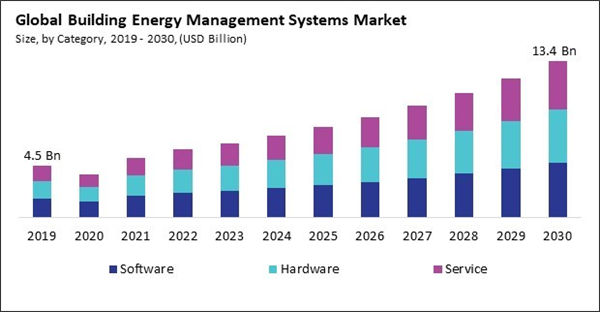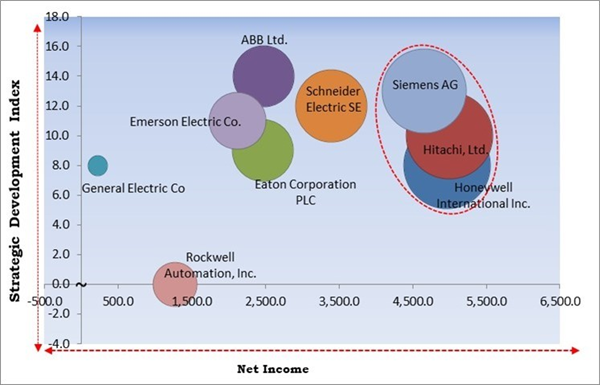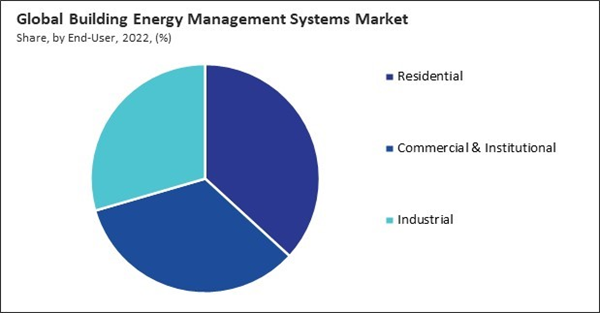The Global Building Energy Management Systems Market size is expected to reach $13.4 billion by 2030, rising at a market growth of 11.1% CAGR during the forecast period.
The concept of smart buildings, equipped with advanced energy management, security, and automation technologies, is gaining popularity in North America. Consequently, the North America region captured $1,533.22 million revenue in the market in 2022. Increased awareness about the benefits of energy management and sustainability practices has prompted organizations in North America to explore solutions like BEMS.
The major strategies followed by the market participants are Product Launches as the key developmental strategy to keep pace with the changing demands of end users. For instance, In November, 2023, ABB Ltd. introduced ABB Ability OPTIMAX to the green hydrogen market. The software helps hydrogen production companies cut electricity-based expenses by up to 20 percent by measuring power flows and carbon dioxide emissions, providing contextual data for optimal energy consumption levels and waste minimization. Additionally, In March, 2023, Schneider Electric SE introduced Next Generation EcoStruxure Building Operation in India, enhancing occupant comfort and building value. The new product offers data accessibility, standardization, and security aided by AI and machine learning.
Additionally, Cybersecurity measures help prevent unauthorized access to BEMS platforms, ensuring that only authorized personnel can control and monitor energy systems. This protects against potential malicious activities and secures the integrity of energy data. Implementing secure communication protocols is essential for protecting data transmitted between different components of the BEMS. Cybersecurity solutions help establish encrypted channels, reducing the risk of interception and tampering during data transmission. Human error remains to be a substantial contributor to cybersecurity incidents. A focus on cybersecurity includes employee training and awareness programs to educate personnel about best practices, phishing threats, and security protocols within BEMS. Hence, rising focus on cybersecurity solutions has been a pivotal factor in driving the growth of the market.
The concept of smart buildings, equipped with advanced energy management, security, and automation technologies, is gaining popularity in North America. Consequently, the North America region captured $1,533.22 million revenue in the market in 2022. Increased awareness about the benefits of energy management and sustainability practices has prompted organizations in North America to explore solutions like BEMS.
The major strategies followed by the market participants are Product Launches as the key developmental strategy to keep pace with the changing demands of end users. For instance, In November, 2023, ABB Ltd. introduced ABB Ability OPTIMAX to the green hydrogen market. The software helps hydrogen production companies cut electricity-based expenses by up to 20 percent by measuring power flows and carbon dioxide emissions, providing contextual data for optimal energy consumption levels and waste minimization. Additionally, In March, 2023, Schneider Electric SE introduced Next Generation EcoStruxure Building Operation in India, enhancing occupant comfort and building value. The new product offers data accessibility, standardization, and security aided by AI and machine learning.
Cardinal Matrix - Market Competition Analysis
Based on the Analysis presented in the Cardinal Matrix; Siemens AG, Hitachi, Ltd., Honeywell International Inc. are the forerunners in the Market. For Instance, In March, 2023, Honeywell International Inc. introduced Blenze Pro, a premium wiring device line for the Indian market, catering to high-end wiring needs in residential, commercial, and hospitality buildings, aiming to expand its presence and meet growing demand for premium products. Companies such as Schneider Electric SE, ABB Ltd., Eaton Corporation PLC are some of the key innovators in Market.Market Growth Factors
The global urbanization wave is leading to more residential and commercial buildings being constructed. As urban areas expand, the demand for BEMS rises to ensure that these structures are equipped with efficient energy management systems. Infrastructure development involves numerous construction projects globally. BEMS becomes integral to new construction projects, ensuring the buildings are energy efficient. BEMS is integrated into these structures to align with sustainability goals and reduce energy consumption. Urban infrastructure includes transportation hubs and smart infrastructure projects. BEMS manages energy consumption in transit terminals, airports, and other critical urban transportation facilities. Thus, because of the global urbanization and infrastructure development, the market is anticipated to increase significantly.Additionally, Cybersecurity measures help prevent unauthorized access to BEMS platforms, ensuring that only authorized personnel can control and monitor energy systems. This protects against potential malicious activities and secures the integrity of energy data. Implementing secure communication protocols is essential for protecting data transmitted between different components of the BEMS. Cybersecurity solutions help establish encrypted channels, reducing the risk of interception and tampering during data transmission. Human error remains to be a substantial contributor to cybersecurity incidents. A focus on cybersecurity includes employee training and awareness programs to educate personnel about best practices, phishing threats, and security protocols within BEMS. Hence, rising focus on cybersecurity solutions has been a pivotal factor in driving the growth of the market.
Market Restraining Factors
High initial costs contribute to a risk-averse decision-making environment, especially in industries focusing on immediate financial returns. Organizations may hesitate to invest in BEMS without a clear and quick payback period. Organizations face various capital expenditure priorities, such as equipment upgrades, facility expansions, and technology investments. The fear of investing in a system that can become outdated may contribute to hesitations in committing to high initial costs. The high initial costs of BEMS implementation can strain organizations’ cash flow, particularly those with tight financial positions. This strain may lead to delayed or scaled-down investments in energy management. Thus, high initial costs of BEMS can slow down the growth of the market.By End-User Analysis
Based on end-user, the market is classified into residential, commercial & Institutional, and industrial. In 2022, the residential segment witnessed the largest revenue share in the market. Growing environmental awareness has prompted individuals to seek sustainable practices, including reducing their carbon footprint. Residential BEMS enable homeowners to make environmentally conscious choices by optimizing energy usage, reducing waste, and contributing to energy conservation. Residential BEMS can contribute to demand response initiatives, allowing homeowners to adjust their energy consumption based on grid signals. This responsiveness aids in grid stability and reliability during peak demand periods.By Category Analysis
By category, the market is categorized into service, software, and hardware. The service segment covered a considerable revenue share in the market in 2022. Installation and deployment services involve the physical setup, configuration, and integration of BEMS hardware and software components within a building’s infrastructure. This ensures that the BEMS system is properly installed and ready for operation. Training services provide educational programs for end-users, facility managers, and maintenance staff to ensure they understand how to use and manage the BEMS system effectively. This includes training on system functionalities, troubleshooting, and best practices.By Regional Analysis
Region-wise, the market is analysed across North America, Europe, Asia Pacific, and LAMEA. In 2022, the Asia Pacific region led the market by generating the highest revenue share. The Asia Pacific region is experiencing rapid urbanization and infrastructure development, leading to new commercial buildings, residential complexes, and industrial facilities being constructed. Rising urbanization, industrialization, and population expansion drive energy demand in the Asia Pacific region. The use of renewable energy sources, like solar and wind power, is growing across the Asia Pacific region. The Asia Pacific region's fast-expanding commercial and industrial sectors have raised energy demand.Recent Strategies Deployed in the Market
- Jan-2024: Honeywell International Inc. came into partnership with NXP Semiconductors, a Dutch semiconductor designer and manufacturer, to enhance building energy management. The collaboration aims to enhance building operations intelligently by incorporating NXP Semiconductors' neural network-enabled, industrial-grade applications processors into Honeywell's building management systems (BMS).
- Jan-2024: Honeywell International Inc. has launched Advance Control for Buildings platform; an automated building management system meant to support energy efficiency and improve operational effectiveness. The system includes built-in cybersecurity and technology for faster network speeds while also using existing wiring, allowing for reduced installation costs, time, and waste generation.
- Nov-2023: ABB Ltd. introduced ABB Ability OPTIMAX to the green hydrogen market, aiming in cost reduction by offering real-time visibility of energy consumption. The software helps hydrogen production companies cut electricity-based expenses by up to 20 percent by measuring power flows and carbon dioxide emissions, providing contextual data for optimal energy consumption levels and waste minimization.
- Oct-2023: Hitachi Energy, a subsidiary of Hitachi, Ltd., acquired eks Energy, a leading supplier of power electronics and energy management solutions, from Powin LLC (Powin), a top global energy storage system provider. This strategic investment enhanced their position in power electronics and energy management solutions.
- Aug-2023: GE Vernova, a part of General Electric Co, acquired Greenbird Integration Technology AS, a Norwegian software firm, to expedite GridOS innovation and simplify energy data integration for utilities. Greenbird's utility-centric technology and data integration specialists will enhance the capabilities of the GridOS software portfolio, enabling grid operators to seamlessly connect systems and scale data integration efforts.
List of Key Companies Profiled
- ABB Ltd.
- General Electric Company
- Honeywell International, Inc.
- Hitachi, Ltd.
- Siemens AG
- Schneider Electric SE
- Emerson Electric Co.
- Rockwell Automation, Inc.
- Eaton Corporation PLC
- mCloud Technologies Corp.
Market Report Segmentation
By Category- Software
- Hardware
- Service
- Residential
- Commercial & Institutional
- Industrial
- North America
- US
- Canada
- Mexico
- Rest of North America
- Europe
- Germany
- UK
- France
- Russia
- Spain
- Italy
- Rest of Europe
- Asia Pacific
- China
- Japan
- India
- South Korea
- Singapore
- Malaysia
- Rest of Asia Pacific
- LAMEA
- Brazil
- Argentina
- UAE
- Saudi Arabia
- South Africa
- Nigeria
- Rest of LAMEA
Table of Contents
Chapter 1. Market Scope & Methodology
Chapter 2. Market at a Glance
Chapter 3. Market Overview
Chapter 4. Competition Analysis - Global
Chapter 5. Global Building Energy Management Systems Market by Category
Chapter 6. Global Building Energy Management Systems Market by End-User
Chapter 7. Global Building Energy Management Systems Market by Region
Chapter 8. Company Profiles
Companies Mentioned
- ABB Ltd.
- General Electric Company
- Honeywell International, Inc.
- Hitachi, Ltd.
- Siemens AG
- Schneider Electric SE
- Emerson Electric Co.
- Rockwell Automation, Inc.
- Eaton Corporation PLC
- mCloud Technologies Corp.











